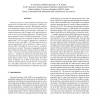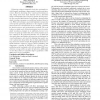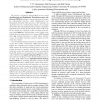76 search results - page 3 / 16 » Redundancy in Instruction Sequences of Computer Programs |
DATE
2003
IEEE
13 years 11 months ago
2003
IEEE
Instruction reuse is a microarchitectural technique that improves the execution time of a program by removing redundant computations at run-time. Although this is the job of an op...
IEEEPACT
2008
IEEE
14 years 14 days ago
2008
IEEE
Technology scaling in integrated circuits has consistently provided dramatic performance improvements in modern microprocessors. However, increasing device counts and decreasing o...
SAMOS
2004
Springer
13 years 11 months ago
2004
Springer
— In this paper we present the Molen programming paradigm, which is a sequential consistency paradigm for programming Custom Computing Machines (CCM). The programming paradigm al...
ISCA
2002
IEEE
13 years 11 months ago
2002
IEEE
We propose a scheme for transient-fault recovery called Simultaneously and Redundantly Threaded processors with Recovery (SRTR) that enhances a previously proposed scheme for tran...
IEEEPACT
2002
IEEE
13 years 11 months ago
2002
IEEE
Traditional compilers perform their code generation tasks based on a fixed, pre-determined instruction set. This paper describes the implementation of a compiler that determines ...



